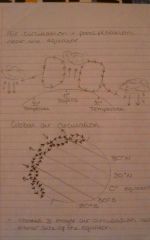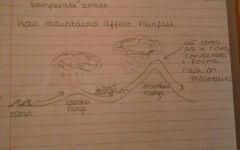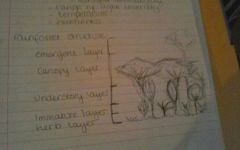![]()
![]()
![]()
Use LEFT and RIGHT arrow keys to navigate between flashcards;
Use UP and DOWN arrow keys to flip the card;
H to show hint;
A reads text to speech;
82 Cards in this Set
- Front
- Back
|
What is a biome? |
- classification of terrestrial communities into major ecological units - correlate with climate types - bone concept: similar regional climates produce similar morphological adaptations in plants and similar structure in vegetation... Possible comparable animal adaptations. |
|
|
What are the world biomes? |
Rainforests Temperate, deciduous forests Burial or taiga forest Grassland Savanna Desert Tundra |
|
|
What is the tundra? |
Most northern biome Short summer Windy and cold Permafrost Water sits on permafrost, boggy soil Anaerobic conditions Soil poor in nutrients |
|
|
Characteristics of tundra plants |
Cold and desiccation tolerant Completes life cycle in short summer season Eg, bearberry, caribou moss, tufted saxifrage |
|
|
Characteristic of tundra animals |
Adaptations to environment, eg extra layers of fat and ability to hibernate over long periods (lack food) Birds migrate south over winter,causing constant population changes |
|
|
What is the taiga? |
Long severe winters (up to six months, temp below freezing) Short summer (50-100 frost free days) Wide range of temperatures Mean annual precipitation 30-45cm, but low evaporation makes it a humid climate |
|
|
Characteristics of taiga plants |
Needle leaf,coniferous trees are dominant plants A very few species in the 4 main genre are found: the evergreen spruce, fir and pine, and the deciduous larch or tamarack Eg, paper birch, Siberia larch, jack pine, black spruce |
|
|
Characteristics of taiga animals |
Adaptations to environment, eg extra layers of fat, ability to hibernate Eg, American black bear, timber wolf, snowshoe rabbit |
|
|
What is the prairie? |
Grassland Prairies: generally humid and covered in dense tall grass, few trees with mist on hill slopes or near springs and rivets, soil rich in nutrients thus exploited by farmers for centuries |
|
|
Prairies plants |
Purple cone flower, buffalo grass, bush morning glory |
|
|
What is the steppe? |
Grassland Vegetation adapted to drier climate, grass generally shorter than on priaries Virtually semi arid deserts in the making Highly threatened by over grazing |
|
|
Steppe plants |
Sweet vernal, milk vetch, tumble weed |
|
|
What is the savanna? |
Grassland Distinguished by warmer,drier climates and seasonal draughts Vegetation is highly adapted to the hot and dry climate |
|
|
Savanna plants |
Baobab, elephant grass, eucalyptus |
|
|
Grassland animals |
Comprised of grazing animals, their predators, and a wide range of burrowing mammals such as ground squirrels and ferrets Eg, bison, antelope, black tailed prairie dog, lions |
|
|
What is the deciduous forest? |
Similar to taiga biome, with a milder, shorter winter Gymnosperms, deciduous trees Soil is richer than borial forests, and larger assortment of forest floor plant life Also due to forests canopy layer is thinner, allowing more light and heat to penetrate |
|
|
Deciduous forests plants |
Beech, lady fern, pecan, bluebell wood |
|
|
Deciduous forest animals |
Grey squirrel, wild boar, woodpecker, fox |
|
|
What are deserts? |
Arid deserts generally occur at low altitudes Season dry and hot, few occcurances of rain in the winter Heat peaks to extremes during day as no clouds to shield earth from sun Not uncommon for rain to evaporate before reaching ground Sand usually fine or course and rocky Semi arid deserts: seasons more defined, low rainfalls during winter |
|
|
Desert plants |
Saguaro cactus, barrel cactus, Joshua tree, creosote bush, octillo |
|
|
Desert animals |
Kangaroo rat, rattlesnake, sand cat, bighorn sheep |
|
|
What are tropical Rainforests? |
Temp 20-25c , varies little throughout year Precipitation is evenly distributed with annual rainfall exceeding 2000mm Soil is nutrient poor and acidic Decomposition is rapid and soils are subject to heavy leeching |
|
|
Tropical Rainforests plants |
Bromeliads, tropical vines, Grey teak, curare, catharanthus roseus |
|
|
Rainforest animals |
Gibbon, macaw, fruitbat, leaf cutter ants |
|
|
What is the alpine? |
Found in mountain regions all around world At an altitude of 3000m or more Just below snow line of a mountain Summer temps 10-15c, in winter temps are below freezing Winter can last October to may Temp can change from warm to freezing in a day |
|
|
Alpine plants |
Bear grass, wild potato, alpine phacolia, moss campion, pygmy bitterroot |
|
|
Alpine animals |
Alpaca, mountain goat, snow leopard, chinchilla |
|
|
What is the chaparral? |
Very hot and dry Winter is mild 10c, wild summer is very hot 40c and dry |
|
|
Chappral plants |
Lebanon cedar, French broom, king protea, Torrey pine |
|
|
Chappral animals |
Black tailed jack rabbit, bezoar goat, island Grey fox |
|
|
Aquatic biome |
Freshwater salt conc, usually less than 1% Saltwater salt conc, more than 3% |
|
|
What are global climate patterns? |
Largely determined by solar energy input, and planets movement in space Sun warms atmosphere,land an water |
|
|
What causes temp variations? |
Cycles of air movement. Evaporation. Dramatic attitudinal variations in climate. Huge amounts of heat energy at tropics, hot air rises, then cools, forming rain |
|
|
What causes seasons? |
The earth is tilted on its axis at 23.5 degrees Tropics have least seasonal variation, increases towards poles Inverse square law, sun is spread over more area at poles |
|
|
Air circulation and precipitation |

Hot air rises, cools , forms rain Creates 3 major air circulation cells either side of the equator |
|
|
Global wind patterns |
Air flowing in the lower levels of the air circulation cells create predictable global wind patterns Earth rotation: land at equator moves faster than at poles, deflects winds creating easterly and westerly air flows Cooling trade winds flow east to west in tropics and subtopic Prevailing winds blow west to east in temperate zones |
|
|
How mountain affect rainfall |

Wind is pushed up the mountain, cooling the air and causing rainfall on the mountains. |
|
|
Abiotic stresses of a desert |
Water High light intensity Temperature ( range, extremes) Nutrients |
|
|
Abiotic stresses of a rainforest |
Water, variable availability Range of light intensity Temperature Nutrients |
|
|
Rainforest structure |

|
|
|
What are ephemeral plants? |
Stress escapers |
|
|
What is plant stress avoidance? |
The reduction of stress |
|
|
Heritable/non heritable stress tolerance |
Heritable = adaptation Non heritable = acclimation |
|
|
What are poikilohydric plants? |
Plants in equilibrium with atmospheric humidity |
|
|
What are homiohydric plants? |
Plants independent of air humidity Controls water loss Maximize water availability |
|
|
What are xerophytes? |
Extreme homiohydric plants |
|
|
What is water deficit? |
Any water content of tissue or cells below the highest water content exhibited aggie most hydrated state |
|
|
What is drought? |
A reduction in the water available to plants that potentially affects growth, development or survival |
|
|
What are the initial responses to water deficit? |
Stomata close Reduction growth - inhibition of DNA synthesis, decreasedleaf expansion Water removal - hydrophilic protein, damage membranes, disrupts bilayer structure = leakage Decreased photosynthesis - most sensitive respiration more variable Root system slight increase osmotic potential Vacuole shrinks - wilting, injurious protoplasmic tensions, plasmolysis |
|
|
What are the effects of continued water deficit stress? |
Decreased protein synthesis Leaf area adjustment, limits size = leaf yellowing |
|
|
Effect of abscisic acid ABA in response to draught |
Levels of ABA rise rapidly in response to drought (often in parallel to Stomata closure) Roots produce aba which is transported to leaves (partial closing of Stomata) Accumulation of aba in wilted leaves (stomates close, aba released from chloroplasts to cytosol, also increased aba synthesis, solute loss - potassium loss from guard cells) |
|
|
How are cytokinins a growth factor? |
Reduction induces leaf senescence and Stomata closure |
|
|
How is ethylene a growth factor? |
Production stimulated by desiccation Responses: Leaf and fruit abscission Leaf epinasty Stomata closure Decreased assimilation |
|
|
What is drought avoidance? |
Mechanisms that minimize the occurrence of damaging water deficits |
|
|
What is drought tolerance? |
Mechanisms that enable the plant tocontinue functioning in spite of plant water deficits |
|
|
What are efficiency mechanisms? |
Mechanisms that optimize the utilization of water |
|
|
Ways of drought avoidance |
Drought escape (complete life cycle in wet season, seeds dormant until next wet season) Water conservation Effective water uptake |
|
|
Drought tolerance mechanisms |
Turgor maintenance Protective solutes, desiccation tolerant enzymes etc |
|
|
What is Turgor maintenance? |
Osmoregulation (or osmotic regulation) Cell solute concentrations are increased Critical mechanism for maintaining physiological activity Active processes, requires energy Occurs in leaves, roots and reproductive organs |
|
|
Solutes in Osmoregulation |
Inorganic ions - especially k+ and cl-, in saline environments na+ and cl- are used as vacuolar solutes, but they must be maintained at low levels in the cytoplasm Organic solutes are more important |
|
|
What are compatible solutes? |
Protective solutes Found in cytoplasm Protects cytoplasm proteins and cell membrane from dessication Function as osmoregulators (eg sugars (trehalose), sugar alcohols (sorbital and manitol), amino acids (especially praline), betaines) Some plants also synthesis drought tolerance enzymes |
|
|
What deficiency mechanisms involve? |
A compromise between water conservation and productivity The optimum balance depends on the aridity of the environment |
|
|
What is the optimal Stomatal behaviour? |
Stomatal opening is often restricted to times when potential evaporation is low, particularly in the morning Stomatal closure happens around midday and in the afternoon in water stressed plants Increases productivity while keeping evaporation to a minimum |
|
|
What are the costs of tolerance mechanisms? |
Any mechanisms that enhances survival in drought conditions tend to decrease the potential dry matter productivity Eg total photosynthesis would decrease by: Stomatal closure Leaf rolling Decreases in leaf area Reductions in growing season length |
|
|
What is CAM? |
Crassulacean acid metabolism At night: Stomata open at night, atmospheric co2 taken up by phosphoenolpyruvate (PEP) which is converted into malate then stored During day: malate is broken down into private and co2, co2 passes into normal c3 photosynthesis |
|
|
What is the hierarchy of photosynthetic efficiency? |
CAM>C4>C3 CAM: reversed Stomatal opening and PEP carboxylase C4: use phosphoenolpyruvate carboxylase to fix co2 C3: use RuBP carboxylase-oxygenase (rubisco) to fix co2 In some plants (both c3 and c4) cam can be induced: C4 plants can utilize high illumination C4 uses 2 more ATP - c3 common in temperate climates |
|
|
How IV co2 taken up by plant? |
Taken up in mesophyll cells by pyruvate transferred to aspartate or malate (4C), migrate to bundle sheath |
|
|
Co2 in hot environments |
Co2 can be limiting: Decreased co2 solubility Control water availability CAM photosynthesis C4 photosynthesis |
|
|
Temperature requirements in plants |
All plants have a unique optimum, maximum and minimum temperature Approach limits = reduced growth Beyond limits = no growth |
|
|
Chilling stress temp for tropics and temprate |
Sub tropics/tropics = damage below 10C Temperate = damage below 5C |
|
|
Chilling stress damage symptoms |
Damage symptoms depend on age, species and duration of exposure Typical symptoms in young seedlings include reduced leaf expansion, wilting, chlorosis Reproduction effected - sterility Extreme - neurosis, death |
|
|
What metabolic dysfunctions does chilling damage reflect? |
Reduced protoplasmic streaming Reduced respiration Reduced photosynthesis Reduced protein synthesis |
|
|
Whys there's diversity of chilling damage responses? |
Multiple low temp sites Single primary site influencing multiple metabolic processes |
|
|
Howdy lipids affect chilling stress? |
Reversible changes in physical state of cellular membranes, membrane lipids mainly 16/18C Unsaturated fatty acids solidify at lower temps, fluid state into a gel (semi-crystaline) Chilling sensitive plants have higher proportion of saturated fats, therefore a higher transition temp Acclimatization = increased unsaturated lipids |
|
|
Effects of loss of membrane fluidity |
Membrane channel disruption Loss of compartmentalisation = solute leakage, membrane based metabolism, respiration, photosynthesis |
|
|
Effect of heat temp stress |
Increased temp = increased membrane fluidity Increased saturated lipids maintain hydrophobic interactions |
|
|
Results of heat stress |
Thylakoid membranes: Photosystem IIAnd o2 evolving complex O2 evolving complex heat inactivated Disrupt e- to PSII Thylakoid membrane fluidity Lateral disruption of pigment protein complexes E- transport Photophosphorylation Chlorophyll fluorescence Energy transfers in PSII |
|
|
Results of plant stress freezing |
Damage : ice formation, osmotic effects (frost plasmolysis) Pure water -38C = spontaneous, homogeneous nucleation Rough surfaces trigger ice nucleation Critical temp decreased by: increased cell sugar content, increased ABA, denovo protein synthesis |
|
|
How is .logging damaging? |
Access to selected trees Forests diverse therefore elected trees scattered Dames neighboring trees by felling Logger use fast mechanical approaches As little as 5% of cut or damaged timber used 10% of tree loss 35% canopy loss Loss of 50% of original trees, remaining trees lost dues to exposure, inhibit growth |
|
|
Fuelwood |
Fuelwood gathering Parts if Africa and Asia logged out due to Fuelwood gathering Consumption doubled in last 20 years UN 1.5-2 billion depend on Fuelwood Alternatives? Switch to other fuel sources, but tradition, poverty, lack of available technology and information etc |
|
|
Effects of mining on the rainforest |
Extraction of gold, copper, diamond, other metals and gemstone Direct forest loss, due to clearing of land in the raunforest Impacts on indigenous people Road construction is opening up the Rainforest |
|
|
Effects of transport |
New roads are opening up the last intact forests 52,000km of new logging roads are being built in the Congo basin, 7500km in the Brazilian amazon Results in habitat destruction, road kill, barrier effects for animals and deforestation |

